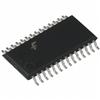FAN5231: Features: • Provides 3 Regulated Voltages Microprocessor core (SpeedStep™-enabled) Microprocessor I/O Microprocessor Clock Generator• High Efficiency Over Wide Load Range•...
floor Price/Ceiling Price
- Part Number:
- FAN5231
- Supply Ability:
- 5000
Price Break
- Qty
- 1~5000
- Unit Price
- Negotiable
- Processing time
- 15 Days
SeekIC Buyer Protection PLUS - newly updated for 2013!
- Escrow Protection.
- Guaranteed refunds.
- Secure payments.
- Learn more >>
Month Sales
268 Transactions
Payment Methods
All payment methods are secure and covered by SeekIC Buyer Protection PLUS.

 FAN5231 Data Sheet
FAN5231 Data Sheet








